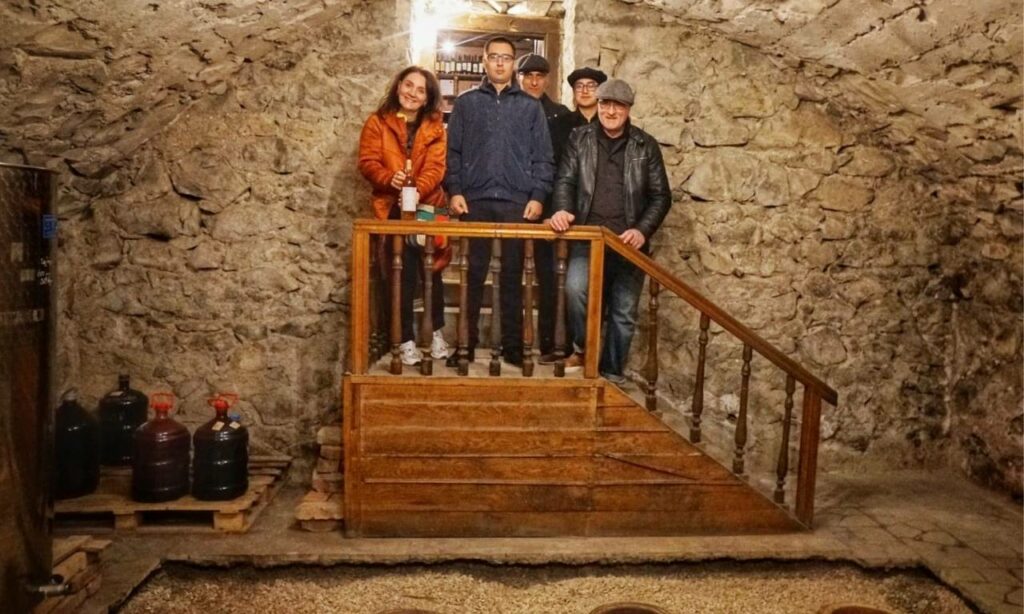From 1817 German (Swabian) settlers, at least 531 families in total, migrated into the South Caucasus. Many of them ended up in Bolnisi (Yekaterinenfeld or Ekaterinenfeld (Russian) / Katharinenfeld (German)), and Asureti (Elisabethtal). They built wonderful German style buildings, with deep wine cellars. They started brewing German beer and making wine in the German way.
But, why, when and how did they come to Georgia? And what became of these settlements and the settlers? Below I outline the key information about Georgia’s German settlements in general, as well as a little more depth on the largest and best preserved German Settlement: Bolnisi (Ekaterinenfeld / Katharinenfeld). Discover the history of Bolnisi and Asureti!
If you’d like to take a tour to Bolnisi or Asureti, there are a lot of reasons to do so! Not only the preserved 19th century German buildings and wine cellars, but also the 8000 year Georgian wine history that begun very close to Bolnisi. Also the oldest history of human life outside of Africa – the 1.85 million years remains of Homo Erectus in Dmanisi. Read our full Bolnisi Region Travel Guide Here.
The precursor to German (Swabian) Immigration to Georgia
- Catherine the Great 1762-4 provided for immigrants from Europe (except Jews) to settle in more desolate areas of Russia in order to develop them.
- Alexander I (1777–1825). His Manifesto of 1804 set higher requirements for the new settlers: they had to be good farmers, specialized in viticulture, silk production, and cattle breeding, or craftsmen.
- Russia’s good relations with the kingdom of Wüttemberg led to people from that area being encouraged to bring skills to the black sea region. Due to the Napoleonic wars in central Europe, emigration was appealing.
- The massive eruption of the Tambora volcano, located in today’s Indonesia, had dramatic effects on the climate in 1815, further aggravating crop failures and famines. In 1816 alone, 20,000 people left their homelands.
- While many emigrated to North America, the majority that chose southern Russia and the South Caucasus came from pious, protestant congregations (the so-called Pietists) – Protestant “separatists” who believed in the imminent return of Jesus. Their conflict with the Lutheran church in Germany led to problems that could be solved by religious freedom granted in the South Caucasus.
- The immigration manifestos offered a lot. A fresh start, agricultural land of considerable size, exemption from military service and all taxes for ten years, and – most importantly – full freedom of religion.
Initial German Settlement in Georgia – From 1817
- 31 Swabian families from Württemberg, arrived in Tbilisi on 21 September 1817. They were given plots of land near the village of Sartichala. The Germans named their settlement Marienfeld, in honor of Maria Fyodorovna (known before her Orthodox baptism as Sophie Dorothee von Württemberg), the sister of Frederick the Great and mother of Alexander I. Marienfeld was the first German settlement in the entire South Caucasus.
- An additional 500 Swabian families who reached Odessa decided to continue to the South Caucasus and eventually arrived in the autumn of 1818. In total 8 settlements were established:
- 1817: Marienfeld (today Sartichala in the municipality of Gardabani);
- 1818: Neu-Tiflis (today the area around Agmashenebeli Avenue in Tbilisi and its adjacent streets);
- Alexanderdorf (today the streets Tskaltubo, Samtredia and Agladze in the Didube neighborhood of Tbilisi);
- Elisabethtal (today the village of Asureti in Tetritskaro municipality);
- Alt-Katharinenfeld (near Shamkir – Ganja, Azerbaijan), abandoned in 1819/20 in favor of Neu-Katharinenfeld (today’s Bolnisi, Georgia);
- 1819: Petersdorf (village of Sartichala in the municipality of Gardabani). GE
- Annenfeld (today’s Shamkir); and Helenendorf (today’s Goygol). Azerbaijan.
Original German Buildings In Bolnisi & Asureti

- The first buildings from 1818 were mud huts, single-storey. Roof tiles and interiors were made by the settlers. Initial construction was aided by Tsarist troops.
- Today’s two-storey houses are half-timbered and laid on stone foundations, with balconies and verandas. Constructed from the 1870s onwards, their mix of southern German and Caucasian elements gave them a special character. According to Swabian building traditions, they had high facades and up to six meters deep cellars. The attic was used to store grain and the cellar was for dairy products, preserves, and wine.
- So, mostly the current preserved buildings would have been built between 1854 and 1900, a few may have been built up until 1941, but most would be earlier, probably. And they were built on top of the original constructions, or next to them.
- Each enclosed courtyard complex also included a summer kitchen, stables, sheds and a garden.
- From the second half of the 19th century, the settlements had anywhere between one to four parallel main streets, which were connected by several side streets. A central square provided the location for the local administration, the church, a school as well as shops and other public buildings.
- Impressive church buildings were erected in many settler communities, such as Katharinenfeld (consecrated in 1854), Helenendorf (consecrated in 1857) and in Elisabethtal (consecrated in 1871). The St. Peter and Paul Church in Neu-Tiflis, built in the 1890s, was financed by the German congregation itself. In Baku, the Evangelical Lutheran Church was consecrated in 1899 and in Annenfeld in 1909.
- The population of the settlements grew sharply until the beginning of the 20th century, from just under 2,700 in 1819 to around to around 12,000 at the turn of the century. Total for all 8 settlements.
- In 1857, residents of Elisabethtal founded Alexandershilf. From the mother settlement Helenendorf, Georgsfeld was established in 1866; Alexandershilf founded Blumenthal in 1891. The new settlements of Gnadenberg, Neu-Dorf and Lindau were set up between 1879 and 1884 on the east coast of the Black Sea, predominantly by Baltic Germans. This process continued until the 1920s. On the territory of today’s Georgia, 21 German settlements have been confirmed so far. Traubenberg – Tamarisi, Marneuli municipality
- In Azerbaijan, in addition to traces of settlements in the capital Baku, a further twelve sites have been identified.
- The October 1941 Decree “On the Resettlement of the Germans from the Georgian, Azerbaijani and Armenian SSR” forced 23,580 Germans from Georgia, 22,741 from Azerbaijan and 212 from Armenia to surrender their all their possessions except for “transportable luggage” and had them deported to Kazakhstan via Tbilisi and Baku, under military escort.
 Take an Asureti, Dmanisi & Bolnisi Tour – focused on history as well as food & wine. Visit the most important historic sites. Explore traditional local cuisine as well as wines made in both Georgian and German styles.
Take an Asureti, Dmanisi & Bolnisi Tour – focused on history as well as food & wine. Visit the most important historic sites. Explore traditional local cuisine as well as wines made in both Georgian and German styles.

Bolnisi History
Bolnisi is the modern Georgian name for what was originally a German (Swabian) settlement. Its former names include Yekaterinenfeld or Ekaterinenfeld (Russian) and Katharinenfeld (German). Below is a brief summary of the history of the city.

- In 1818, 2 German settlements were established. Originally Bolnisi was established elsewhere in 1819, it moved from the area of Azerbaijan called “Ganja” because of the lack of water supply there.
- At the time it was named: Katharinenfeld in honor of Katharina, queen of Wüttemberg.
- In 1826 Kurdish, Persian, and Turkish raiders killed and abducted many inhabitants and burnt houses to the ground.
- The oldest settlement core of Katharinenfeld is located in the area of today’s streets Shota Rustaveli (formerly Garden Street), Giorgi Saakadze and Stefania (formerly Katharinen Street), King Pharnavaz Street (formerly Nikolai Street), Merab Kostava (formerly “Church Street”) and Egnate Ninoshvili (formerly Mill Ditch Street). (The area is marked on our Bolnisi Map below)
- The main church in the center was consecrated in 1854. The bell tower was destroyed by the Soviets, the building was extended and is used as a sports hall today.
- Largest and most developed German settlement in Georgia.
- Grape cultivation began from the very start of the settlements’ history.
- In 1862 Christopher Vohrer founded a joint-stock company, followed in 1868 by the first brewery in the Elizavetpol region, which was always to remain a side business. In 1870, a parent company was founded with four of his sons, “Christopher Vohrer and Sons”.
- In 1916 the name was changed to Ekaterinovka. Then in 1921 upon Soviet occupation of Georgia, to Luxemburg in honor of the Polish-German communist Rosa Luxemburg. In 1943, the village finally received its current name Bolnisi.
- Wealthy wine grower Ernst Allmendinger produced a full documentation of the town in the 1930s.
- In 1941, due to Germany being at war with the Soviets, All Germans in the town apart from women married to Georgian men, were deported to Kazakhstan and Siberia.
- At the outbreak of World War I, all the German villages of Transcaucasia produced about 28 million liters of wine, over eight percent of Russia’s total wine production. With an annual turnover of 12.3 million liters of wine, the Vohrer and Hummel businesses in Helenendorf accounted for almost half of the entire German settlement production and thus about four percent of the total Russian wine trade.
- The Soviets relocated Georgian people from Svaneti and other areas to take over the vacant houses. Today, most of the families in Bolnisi are Georgian, but some have German ancestors and German culinary and cultural traditions still persist to some extent, as well as beer and winemaking! The government is actively working to renovate and revitalize the German history.
Visit Bolnisi & Asureti (Kevmo Kartli)
Asureti is just 45 minutes south of Tbilisi old town, and Bolnisi about 1hr15m from Tbilisi.
 Take an Asureti, Dmanisi & Bolnisi Tour – focused on history as well as food & wine. Visit the most important historic sites. Explore traditional local cuisine as well as wines made in both Georgian and German styles.
Take an Asureti, Dmanisi & Bolnisi Tour – focused on history as well as food & wine. Visit the most important historic sites. Explore traditional local cuisine as well as wines made in both Georgian and German styles.
If you’d like to make a trip to Bolnisi or Asureti, there are a lot of reasons to do so! Not only the preserved 19th century German buildings and wine cellars, but also the 8000 year Georgian wine history that begun very close to Bolnisi. Also the oldest history of human life outside of Africa – the 1.85 million years remains of Homo Erectus in Dmanisi. Read our full Bolnisi Region Travel Guide Here.




